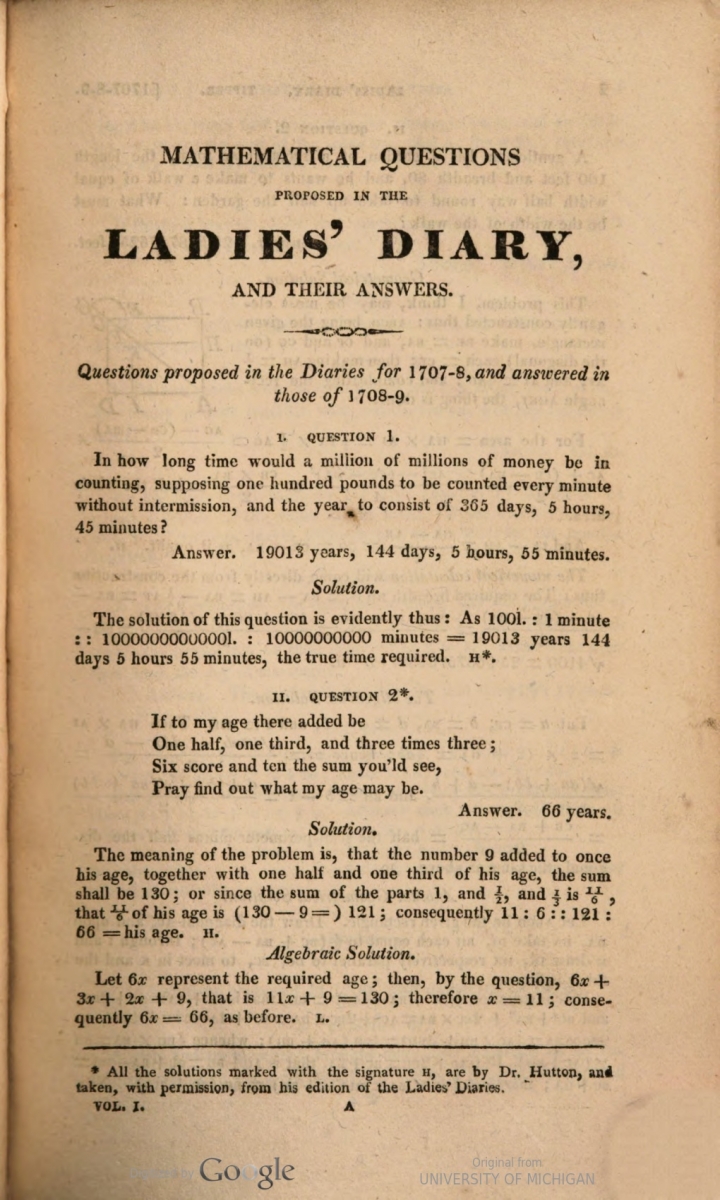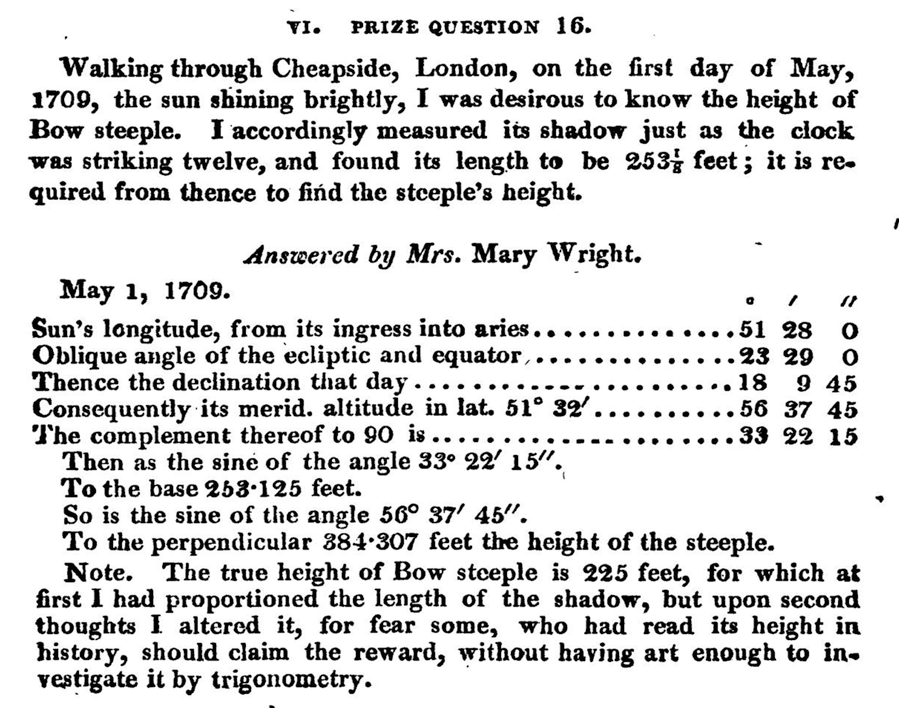- About MAA
- Membership
- MAA Publications
- Periodicals
- Blogs
- MAA Book Series
- MAA Press (an imprint of the AMS)
- MAA Notes
- MAA Reviews
- Mathematical Communication
- Information for Libraries
- Author Resources
- Advertise with MAA
- Meetings
- Competitions
- Programs
- Communities
- MAA Sections
- SIGMAA
- MAA Connect
- Students
- MAA Awards
- Awards Booklets
- Writing Awards
- Teaching Awards
- Service Awards
- Research Awards
- Lecture Awards
- Putnam Competition Individual and Team Winners
- D. E. Shaw Group AMC 8 Awards & Certificates
- Maryam Mirzakhani AMC 10 A Awards & Certificates
- Two Sigma AMC 10 B Awards & Certificates
- Jane Street AMC 12 A Awards & Certificates
- Akamai AMC 12 B Awards & Certificates
- High School Teachers
- News
You are here
'The Ladies Diary': A True Mathematical Treasure - A New Direction
After the initial 1704 issue of the Ladies Diary, editor John Tipper maintained his original format of the materials he thought would please women readers, but soon these readers made their wishes known. They particularly liked the "enigma" puzzles whose correct solutions earned prizes. The answers and their prizewinners would be revealed in the following issue. While the Diary was a women’s periodical, men were also drawn to its contents and joined the ladies as puzzle-solvers and correspondents. In the 1707 issue of the Diary, the editor acknowledged a “Mr. John White from Rutterly in Devon” who had sent in correct answers for the previous year’s enigmas and also enclosed two of his own “arithmetical enigmas,” shown in Figure 5 below.

Figure 5. Two problems originally posed in the Ladies Diary of 1707 were reprinted on the first page of Volume I of Thomas Leybourn's 1817 Mathematical Questions Proposed in the Ladies’ Diary and Their Original Answers, together with Some New Solutions, from its Commencement in the Year 1704 to 1816 (4 vols.). (Source: HathiTrust Digital Archive, from a book held by the University of Michigan Library and digitized by Google)
By 1709, the almanac’s readership was requesting more of these word puzzles, both in enigmatic form and arithmetical in nature. Tipper complied, noting a change in policy and set new standards that would radically alter the mathematical and educational impact of his publication. First, he revised his content to comply with his female readers' preference for intellectually challenging problem-solving situations over cooking advice:
Having observed by a multitude of Letters I have receive from all parts of the Kingdom, That the Enigmas, an Arithmetical Questions, above all other Particulars, give the greatest Satisfaction and Delight to the obliging Fair, I shall in the Diary insist the Longer upon them, and for that Reason defer the Receipts of Cookery, &c. to a more favourable Opportunity: And First of the Nature. (Ladies Diary, 1709, p. 3)
Secondly, he cautioned that the arithmetical problems be within the capacity of his women readers:
I have received several Arithmetical Questions which are Very unfit for this place; my design being not to puzzle, but to Please; not to perplex the Understanding, but to exercise the wit, and a moderate knowledge in Numbers; and therefore those who are pleased to send me any Arithmetical Questions, I desire they may be very Pleasant, and not too hard; and likewise that they may be proposed in verse; which will still be the more taking among the Ladies. (Ladies Diary, 1709, p. 3)
The reserved and socially constrained "Ladies" of England wanted to do mathematics! John Tipper’s accommodation and solicitation for mathematics problems acknowledged the lack of mathematical training provided young women. If they had acquired skills in mathematics, it was usually through self-study and or tutoring by liberal-minded parents or a governess. The prevailing conception held was that females could not engage in anything scientific, let alone mathematics; exposure to it would “fever their brains.” However, the first prize problem was sent in by a man and answered correctly by Mrs. Mary Wright. Over several years, Mrs. Wright would distinguish herself by solving many of the mathematical problems set in the Diary. While the problem was originally given as a lengthy, verbose, one-page verse, it was simply summarized when reprinted with its solution:

Figure 6. A problem originally posed in the Ladies Diary of 1709, together with its solution by prolific problem-solver Mary Wright, was reprinted on page 12 of Volume I of Thomas Leybourn's Mathematical Questions Proposed in the Ladies’ Diary and Their Original Answers ... (1817).
The requirement that problem and answer submissions had to be in verse had been yet another aspect of the Diary promoting gentility and catering to an existing fashionable trend; it was believed that word play, as rendered in verse, marked an agile mind. However, Tipper’s acquiescence in increasing the number of enigmas and adding mathematics problems was a fateful move. It changed the essence and intent of the Ladies Diary to make it a problem-solving journal, a function for which it would be recognized and in which it would excel for over a century.
While the Ladies Diary, over the course of its life, would be directed by a variety of editors, each imposing his particular objectives and experiences, the basic features established by Tipper dominated the Diary:
- The cover exhibited a portrait of the reigning queen.
- An almanac calendar was provided accompanied by astronomical details.
- Answers to previous puzzles, enigmas, paradoxes and mathematical problems would be given and then new sets of puzzles and problems would be posed for the year. Prize questions and enigmas would be designated.
- Occasionally, an expository article on a scientific or mathematical concept would be included. (See Figure 7).
- The scientific integrity of the content was upheld.

Figure 7. Editor John Tipper was especially interested in astronomy and published several articles on the subject, including this one in the 1709 Ladies Diary (p. 3). The prediction Tipper reported here had been made by Edmund Halley ("The Ingenious Captain Hally") in 1705.
Frank J. Swetz (Pennsylvania State University), "'The Ladies Diary': A True Mathematical Treasure - A New Direction," Convergence (August 2018)




